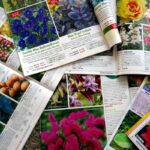working with annuals
Creating themes with annuals is almost like painting, you can create infinite variations of color, contrasting and analogous harmonies, focal points and diffusion hues. The rules are the same as those of basic color theory, with the difference that the components of your art piece are alive.
If you plan the garden well at the beginning of the year you will be able to carry the color theme successfully through the seasons, the flowers will change but the harmony will remain the same.
There are three fundamental color palettes: monochrome, analogous and contrasting.
The monochrome theme is the easiest to achieve, especially in basic colors like white, pink or red, since many flowers come in these hues. Here are some suggestions for monochromatic schemes:
– white: mums, nicotiana, baby’s breath, petunias, snapdragons, sweet alyssum, cleome
– red: celosia, impatiens, red salvia, geraniums, wax begonias, zinnias
– pink: zinnias, sweet William, pink coleus, cosmos, impatiens, petunias, dahlias
– yellow: calendula, mums, sunflowers, marigolds, lantana, moss rose.
– blue: cornflower, ageratum, salvia, clown flower, morning glory, lobelia.
– coppery orange: Siberian wallflower, marigolds, sneezeweed, nasturtiums, tuberous begonias, black-eyed Susan vine.
The analogous scheme combines two or three colors adjacent on the color wheel, much like the picture that accompanies this article. Combine black eyed Susans with yellow calendulas and nasturtiums for a fiery yellow orange and brick red scheme, or lavender, ageratum, lobelia and purple petunias for a purple blue combination.
A contrasting theme combines one or two adjacent colors with an opposite, for instance tequila lime zinnias and lime green nicotiana with salvia, flax and decorative cabbage.
I would love to try a contrasting color scheme this year, but I have a perennial garden, so it will have to incorporate all the roses, bee balms, cone flowers, peonies and delphiniums, so it will need to be a burgundy lavender and golden yellow theme.




 Previous Post
Previous Post Next Post
Next Post




